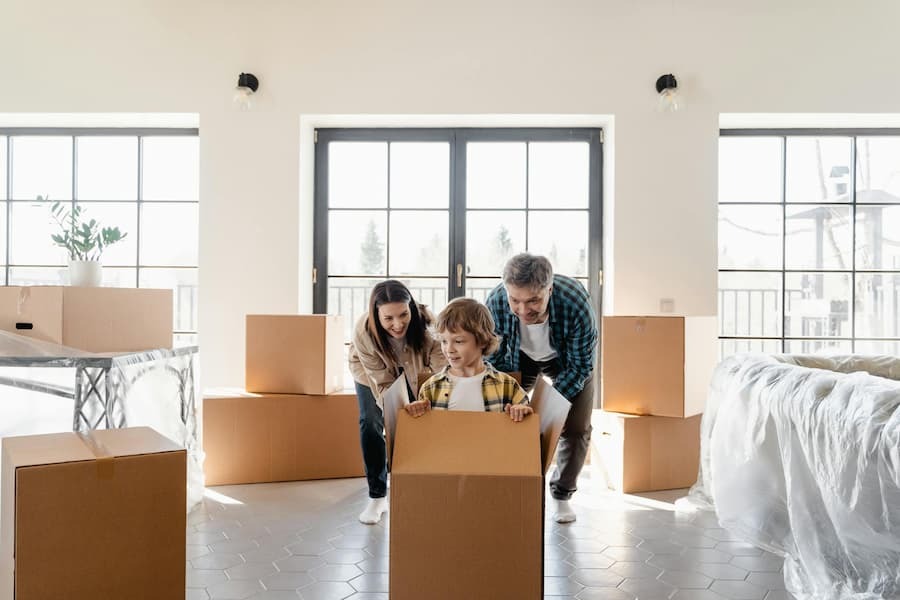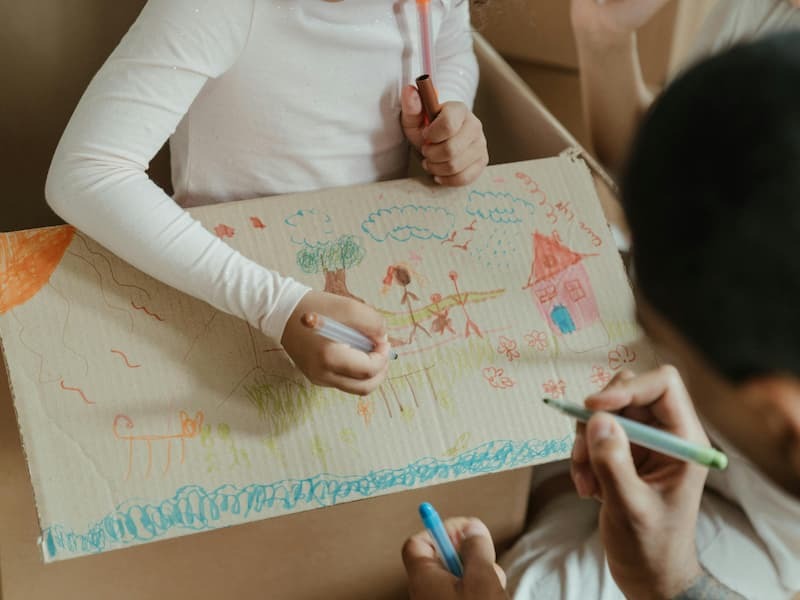Moving with kids is chaos and charm intertwined in ways you never imagined! First of all, it's really hard to leave everything familiar behind, isn't it? But that's where we step in and prepare this article for you. Let's make new friendships, laugh at the mess and create memories that will last a lifetime. This move will be hard, but the outcome will be worth it. WellKnown Moving is with you!
How to Prepare Your Child for Moving
Understanding Your Child's Perspective
Children's Need for Stability and Familiarity
Kids see the world differently. Familiarity, routine—those are their anchors. Rip those away, and you’re staring at a whirlwind of anxiety, stress, maybe even a meltdown or two. Studies scream it loud and clear: lose that comfort zone, and kids’ emotional well-being takes a hit. But here’s the twist—handle it right, and this could be their launchpad to resilience, adaptability, and better social chops than you’ve ever seen.
The Psychological Impact of Moving on Kids
Have you ever heard of kids moving too much and ending up hallucinating or delusional? Sounds wild, doesn't it? But it is true - A study by Today's Parent found that kids who change schools more than three times during their childhood? There's a 60% chance of developing psychotic symptoms. But it's true. A study by Today's Parent found that children who change schools more than three times during their childhood have a 60% chance of developing psychotic symptoms.
But can moving have a positive affect on a child? Moving can also switch them around, turning them into social butterflies, cultural connoisseurs and champions of adaptation.
It would seem that there is no magic number, but it turns out there is: before they enter school life knee-deep. We're talking about ages 4 to 8. Old enough to cope, but not yet locked into their social environment.
Parental Self-Care and Emotional Management
Have you ever noticed how your stress is transmitted to your children? Yes, they pick up on everything. Studies have shown that. Children are extremely empathic. You're juggling a million moving parts, but self-care? That's out of the question. Mindfulness, light exercise and relying on your social circle can all save your sanity and, in turn, theirs.
Communicating About the Move
Strategies for Honest and Age-Appropriate Conversations
Openness and honesty when discussing moving with children is very important. You must have open communication. But the approach to this communication will be different for children of different ages and levels of understanding.
Here’s how you can approach it based on the child’s age:
- 📘 For Toddlers and Preschoolers (Ages 1-4): Keep it chill. No need for long-winded speeches here. Just hit them with the basics—something like, "Hey, we’re getting a new house with a huge room for all your toys!" Toss in some storybooks, maybe a cartoon with a moving plotline, and boom—they get it. They're not looking for a deep explanation; they just need to know the new place is cool.
- 🌟 For School-Aged Children (Ages 5-12): Now we get into the details. Still keeping it upbeat, but you’ve gotta throw in the perks. New friends, a park down the street, or the coolest after-school club—whatever lights their eyes up. But don't sugarcoat it too much; they’ve got questions, probably more than you expect. Answer them straight, but with a dash of optimism—always leave them looking forward to something. Their concerns? Valid. Address those too.
- 💬 For Teenagers: You're not selling them on "new rooms" anymore. It’s all about respecting their emotions now. Let them vent about missing their squad, leaving behind the place they’ve built their life in. They need that space, and you need to acknowledge it. But at the same time? Show them the silver lining. New extracurriculars, a fresh start, even the potential for a better school. Involve them in decisions when you can—whether it's picking out their room or checking out new schools. This move? It's theirs as much as it is yours. It is important to show that moving is also part of the teen's decisions and part of their responsibility.
Whether it's walking the pen or slamming the door, make sure their voice is important. Listen to their fears. Celebrate their excitement. Let them know that this step may be serious, but together? You can make it work. Every question, every feeling is valid and important.
Involving Children in the Moving Process
Involving kids in the moving process helps them feel in control and accepted. Packing boxes? Turn that into a game. Choosing decor for their new room? Let them go wild with ideas. You’re not just moving them, they’re part of the team. Make them feel it.
How To Support Children During A Move

The Role of Consistency in Children's Emotional Stability
Routines - mealtime, bedtime, bedtime, bedtime story - are the pillars of a child's emotional stability. A study by the University at Albany-SUNY found that children who stick to routines manage their time better, concentrate better, and are less likely to have attention problems later in life. Regularity in routines is about safety. The security they need while everything else is changing.
Addressing Feelings of Loss and Homesickness
Kids aren't just leaving a house; they're leaving a part of themselves behind. Help them process that by engaging in activities that honor the past but also pave the way for the future:
- 📦 Memory Box Creation: Let them pack a box full of treasures—photos, toys, memories. It’s a tangible way to say goodbye, without letting go entirely.
- 💻 Digital Memory Album: Create a shared photo album of their old home, friends, favorite places. Keep those connections alive, even if just virtually.
- 🚗 Farewell Tour: Take one last lap around the old neighborhood. Snap some pics, gather souvenirs, share stories—give them the closure they need.
- 🗺️ Map of Memories: Draw a “memory map,” marking places they loved. Attach photos, memories—make it an art project. Moving forward doesn’t mean erasing the past.
Building New Connections
Encouraging Social Integration
New faces, new places—it’s overwhelming for kids. But you can ease them in (based on article):
- 🏀 Engage in Extracurricular Activities: Sign them up for sports, clubs, music lessons—whatever gets them involved. It’s the quickest way to meet friends and build confidence.
- ❤️ Promote Parental Support: Be their number-one cheerleader. Encourage them to dive into those activities.
- 🌱 Highlight the Development of Desirable Attributes: Through these activities, they’re not just making friends—they’re building discipline, responsibility, and social skills!
Staying Connected with Old Friends
Maintaining old friendships is just as important as building new ones. Saying goodbye doesn’t mean goodbye forever:
- 💻 Leverage Technology: Tech’s your friend here—video calls, online games, social media. Keep those old connections alive.
- ✈️ Plan Visits: Whenever possible, plan trips back to the old neighborhood. Those visits are crucial for reminding kids that while they’re building new friendships, their old ones still matter.
Practical Strategies For Moving With Kids

Moving with kids doesn’t have to be a logistical nightmare. We’ve got you covered:
The Power of Preparation
Checklists and Timelines for a Family-Friendly Move
Preparation is everything. At WellKnown Moving, we’ve got a moving checklist that covers every step—packing, organizing, settling in. Best part? It’s customizable and online on Google Sheets, built to adapt to your specific move.
Get Your Moving Checklist
Selecting the Right Time to Move
Timing is everything when you’ve got kids in tow. Consider school schedules, big life events, and plan around those.:
| Consideration | Optimal Time to Move |
|---|---|
| Academic Year | Summer Break |
| Transition Between Schools | After completing a major grade level |
| Family Milestones | After big events (birthdays, holidays, etc.) |
Making the New Place Feel Like Home

Customizing Children’s Spaces
Their new room? Make it theirs. Let them pick the colors, themes, decorations—whatever gives them a sense of control. The quicker they feel settled, the quicker they’ll embrace the change.
Quick Wins to Establish Familiarity and Comfort
Fast-track that “home” feeling with a few key moves:
- 🖼️ Create a Memory Wall: Dedicate a space to family photos, their artwork, anything that makes the new space theirs.
- 🍽️ Set Up a Welcome Ritual: First night? Celebrate with a “Welcome to Our New Home” dinner or picnic. Talk about the adventures waiting ahead.
- 🧸 Unpack Personal Items First: Prioritize setting up their room. Surround them with their favorite things—instant comfort.
- 🛋️ Create a Comfort Corner: Designate a cozy area in the house where your child can relax with comfort items like plush toys, cushions, or a small tent. This can be their go-to spot for feeling safe and comfortable.
- 🚪 Personalize Door Signs: Let them design their own door sign. That simple touch goes a long way in making the new room feel like home.
Conclusion
Moving with kids? It’s not just about logistics, it’s about growth, resilience, and family. Involve them in decisions, reestablish routines quickly, nurture old friendships, and build new ones. Through all the stress, there’s opportunity. Opportunity for growth, for strengthening family bonds, for creating memories that will last a lifetime..
Key Takeaways
- 🏡 Involve children in move-related decisions (e.g., choosing new rooms, decoration).
- ⏰ Quickly reestablish family routines (e.g., regular mealtimes, bedtimes) for normalcy.
- 👫 Encourage maintaining old friendships and building new ones.
- 🌳 Participate in local community activities to strengthen family bonds.
- 💬 Dedicate time for family discussions and reflections on the move for emotional support.
Visit our moving forum where you can tell your story or get answers to your questions!
